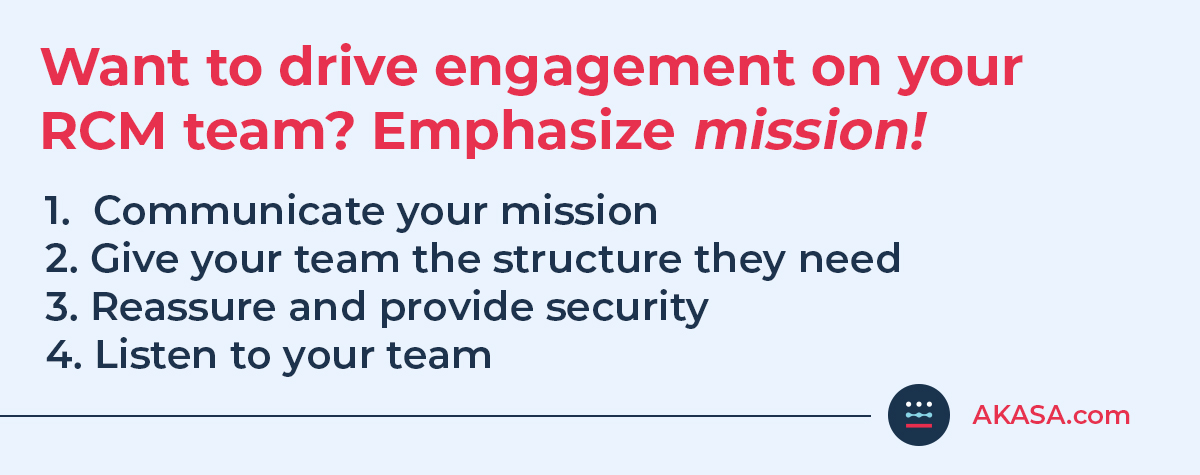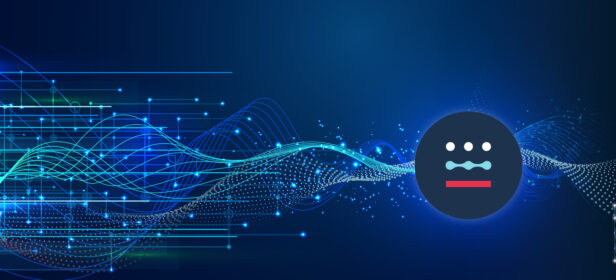The Gist
Every healthcare RCM leader can recognize a disengaged employee: they call in frequently, often have a negative attitude, and don’t stick around for long. It’s bad for your department and it’s bad for the employee, too. Fortunately, there’s a secret sauce that can help you drive engagement in your revenue cycle department. And it’s right under your nose. If you can convey your organization’s mission and purpose, you can drive engagement like never before. Amy Raymond, AKASA’s VP of revenue cycle operations, has a story to prove it and solutions for implementing it in your own organization.
As revenue cycle leaders, we all know the telltale signs of a disengaged healthcare RCM employee: they do the bare minimum (or less), make sloppy mistakes on claims or other simple tasks, have decreased productivity, seem unhappy, start showing attendance issues, and are probably job hunting in their spare time.
On the other hand, engaged employees are more likely to stay with your organization and are more productive to boot. With staffing challenges prevalent in most healthcare organizations, increased productivity and less turnover are two benefits you can’t ignore.
While engagement is important, it’s also difficult to measure and emphasize. How do you take the “why” behind what you do and make it something tangible? Something your employees can relate to the countless claim status checks, auth initiations, and denial cases?
On top of this, driving engagement in a space as stressful as healthcare isn’t easy. Between staffing challenges and ongoing pandemic complications, healthcare leaders everywhere are feeling the burn.
I can tell you high employee engagement isn’t a myth. It’s entirely possible, even in the fast-paced world of the healthcare revenue cycle. I know this because I’ve seen it firsthand.
High Friction, Low Engagement
In a previous life, I was part of an implementation team responsible for setting up new EHR systems in care organizations. Oftentimes our days would go something like, “We’re going to take everything you do, rewrite all your processes, put you in a totally new system, and train you on how to use it and do your work in an entirely different way than before — all while maintaining standards of patient care and productivity at the same time, of course.”
It was understandably adversarial and high friction at times. We were coming in and changing things for entire departments, impacting numerous people. We knew our work would help the organizations we served, but often didn’t see that firsthand. And yet, this job led me to one of the most memorable and engaged points of my professional life.
The work of sitting down and rewriting processes for organizations, while acting as the mediator between the EHR and our organization, felt very transactional. It was easy to forget the impact of our work.
~ Amy Raymond, VP of Revenue Cycle Operations at AKASA
Remembering the “Why” Behind Our Workflows
We had just signed a contract with a faith-based hospice house care center. We were used to going to billing offices and corporate settings, places typically separate from the areas where care was provided. But the hospice center had invited us to a kickoff meeting, and we had no idea what to expect before arrival.
The center was a beautiful facility, made to be very homey and welcoming, with patients in rooms just out of sight of the front desk. None of us knew this at the time, so we were surprised to walk through the doors and see a Christmas tree, caretakers, and patients.
We had the humbling experience of walking past the front desk and through the halls of the facility, watching as caretakers tended to dying patients. Then, we arrived at what we thought was simply a kickoff meeting, but it turned out they had combined it with a larger staff meeting to build excitement about the project.
At many faith-based hospice centers, it’s a common practice for volunteers to create prayer or comfort shawls for the patients. Volunteers think of the patients while making these, then a chaplain prays over them before delivering them to the patient.
Shortly after we got to the kickoff and staff meeting, the hospice chaplain arrived. She brought prayer shawls with her. We were all standing in the front of the room, and after we had introduced our team to the group, the staff placed a shawl over each of us and performed a blessing, just as they did for those they cared for down the hallway and out in the community. Every member of our team, regardless of background or faith, were humbled and honored in that moment.
In the revenue cycle, it’s easy to feel disconnected and not see how closely related our work is to the work done by those caring for patients. We spend countless hours ensuring bills are accurate and patients are tended to. However, there’s often a disconnect between the work we’re doing and the “why” that makes it so important.
The moment those shawls were placed over our shoulders, every member of our team felt the importance of our mission and the work we do.
With that shawl, we all realized: our job makes a difference, and these are very real lives we’re bettering by doing what we do.
Suddenly, every process we changed and every piece of documentation we automated, we were thinking about how it impacted patient care and the clinicians caring for those patients.
~ Amy Raymond, VP of Revenue Cycle Operations at AKASA
How to Emphasize Mission on Your RCM Team
You can often feel disconnected from the rest of healthcare when you’re working in the revenue cycle.
When you make your organization’s mission important to your revenue cycle team, you give them a reason to fully show up each and every day. But first, you need to connect your staff to your mission.

There are a few steps you can take to make this happen.
1. Communicate your mission
You need to communicate your mission — all the time. During onboarding, make sure the mission of your organization, and department if applicable, is front and center.
Weave language from your mission into your departmental communications, and be sure you’re a great example of embodying your mission, as well.
Communication is at the heart of engagement. Without it, you can’t convey the importance of your organization’s mission. You also can’t build trust through transparency, reassurance, and helpful feedback.
~ Amy Raymond, VP of Revenue Cycle Operations at AKASA
At AKASA, our mission is to build the future of healthcare with AI.
I make it a point to regularly talk about our mission when speaking to my team of revenue cycle specialists. I let them know how our work is impacting the mission and progress of our automation, and how our work is directly impacting the difference providers make in their respective communities.
2. Give your team the structure they need
While communication around your mission can remind your team of the “why” behind their work, the right structure gives your team a foundation on which to build success.
Go beyond rules or quotas and provide structure in the way of support. Is your team empowered to embody your organization’s mission and truly thrive? Do they have clear directions around not only what they should do, but how they should do it? And do you have the right managers and support staff to make your team successful and comfortable?
Do you have a cross-training program in place? Read more about how it’s the secret to a productive, engaged team.
3. Reassure and provide security
Reassure your team of the good work they’re doing. When someone stumbles, help them succeed and then celebrate those wins. If someone serves as a great example of what it means to live your mission, praise them.
And, most of all, communicate with honesty and transparency.
Nothing provides security and drives engagement like honest, transparent communication. This is especially true during periods of change, like when automation is being brought in to assist or your organization is experiencing higher demands than usual.
4. Listen to your team
Working in RCM can be emotionally and mentally challenging. Seemingly endless queues, ever-changing processes, and patients needing help at the heart of it.
Make sure to listen to your team about what they’re feeling and what they need.
Collect feedback from your team, whether you’re planning or experiencing change, or simply working on driving home the importance of your mission. Ask them if they’re feeling more connected to the mission, what makes them nervous about a particular change, how you can support them, and so on.
Even if you don’t follow their feedback or advice, use language from their feedback in your updates on the organization. A big part of communication is making sure your team knows you hear them, and including their language shows you do.
Find Your Shawl
I realize not every person or organization is lucky enough to have an experience as profound as mine in that hospice. It’s not every day in the healthcare revenue cycle that we see the impact we make. This doesn’t mean you can’t find your own “shawl” that grounds your mission and the “why” for your team.
As leaders, we have the chance to help our team see that impact and understand the value of what we do. Not only will this help engagement, it will also give people another reason to stay.
Some days I show up to work in the revenue cycle space. But most of the time I’m showing up because I’m excited about the things we’re doing more broadly at our organization.
Sure, it’s been more than a decade since that shawl was draped over me. That experience even led me to start making shawls and baby blankets for donation. Now, as a leader in the revenue cycle space, I make it my mission to give our team purpose.

I’m excited about the technology at AKASA. By talking openly about the impact our work and AI-powered automation has on the revenue cycle experience, my team is engaged and excited, too. In fact, automation can actually drive RCM employee engagment.
I found engagement in a high friction, low engagement environment. You can do the same for your team, and it all starts with the “why.”
Emphasize the why and you’ll give your employees a reason to stay — and stay engaged.

Amy Raymond serves as the senior vice president of revenue cycle operations and deployments at AKASA, where she maintains operational responsibility for the production and performance of the firm’s AI-driven automation platform. Across her 25-year career in revenue cycle, Raymond has held several leadership, consulting, and implementation roles. Her industry experience includes tenures at national and regional health systems, as well as numerous care settings and specialties. Most recently, Raymond served as a senior leader in the revenue cycle technology vertical at Advisory Board. Her extensive professional expertise includes: end-to-end revenue cycle operations, process redesign/optimization, patient financial experience improvement, technology deployment/adoption, change management, and employee engagement. As a military spouse, Raymond is a passionate advocate for mil-spouse hiring and community support.











